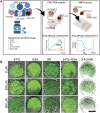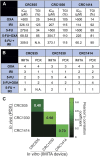A comparative study of tumour-on-chip models with patient-derived xenografts for predicting chemotherapy efficacy in colorectal cancer patients
- PMID: 36147524
- PMCID: PMC9488115
- DOI: 10.3389/fbioe.2022.952726
A comparative study of tumour-on-chip models with patient-derived xenografts for predicting chemotherapy efficacy in colorectal cancer patients
Abstract
Inter-patient and intra-tumour heterogeneity (ITH) have prompted the need for a more personalised approach to cancer therapy. Although patient-derived xenograft (PDX) models can generate drug response specific to patients, they are not sustainable in terms of cost and time and have limited scalability. Tumour Organ-on-Chip (OoC) models are in vitro alternatives that can recapitulate some aspects of the 3D tumour microenvironment and can be scaled up for drug screening. While many tumour OoC systems have been developed to date, there have been limited validation studies to ascertain whether drug responses obtained from tumour OoCs are comparable to those predicted from patient-derived xenograft (PDX) models. In this study, we established a multiplexed tumour OoC device, that consists of an 8 × 4 array (32-plex) of culture chamber coupled to a concentration gradient generator. The device enabled perfusion culture of primary PDX-derived tumour spheroids to obtain dose-dependent response of 5 distinct standard-of-care (SOC) chemotherapeutic drugs for 3 colorectal cancer (CRC) patients. The in vitro efficacies of the chemotherapeutic drugs were rank-ordered for individual patients and compared to the in vivo efficacy obtained from matched PDX models. We show that quantitative correlation analysis between the drug efficacies predicted via the microfluidic perfusion culture is predictive of response in animal PDX models. This is a first study showing a comparative framework to quantitatively correlate the drug response predictions made by a microfluidic tumour organ-on-chip (OoC) model with that of PDX animal models.
Keywords: 3D culture; PDX (patient derived xenograft); dose response; in vitro; in vivo; microfluidic lab-on-a-chip; organ-on-chip (OoC).
Copyright © 2022 Ong, Chia, Wong, Zhang, Chua, Loo, Chua, Chua, Tan, Hentze, Tan, DasGupta and Toh.
Conflict of interest statement
The authors declare that the research was conducted in the absence of any commercial or financial relationships that could be construed as a potential conflict of interest.
Figures





Similar articles
-
Establishing a Microfluidic Tumor Slice Culture Platform to Study Drug Response.Curr Protoc. 2023 Mar;3(3):e693. doi: 10.1002/cpz1.693. Curr Protoc. 2023. PMID: 36912175
-
Establishment of bladder cancer spheroids and cultured in microfluidic platform for predicting drug response.Bioeng Transl Med. 2023 Dec 4;9(2):e10624. doi: 10.1002/btm2.10624. eCollection 2024 Mar. Bioeng Transl Med. 2023. PMID: 38435820 Free PMC article.
-
Organ-on-Chip platforms to study tumor evolution and chemosensitivity.Biochim Biophys Acta Rev Cancer. 2022 May;1877(3):188717. doi: 10.1016/j.bbcan.2022.188717. Epub 2022 Mar 16. Biochim Biophys Acta Rev Cancer. 2022. PMID: 35304293 Review.
-
Characterization of drug responses of mini patient-derived xenografts in mice for predicting cancer patient clinical therapeutic response.Cancer Commun (Lond). 2018 Sep 26;38(1):60. doi: 10.1186/s40880-018-0329-5. Cancer Commun (Lond). 2018. PMID: 30257718 Free PMC article.
-
Organ-On-Chip Technology: The Future of Feto-Maternal Interface Research?Front Physiol. 2020 Jun 30;11:715. doi: 10.3389/fphys.2020.00715. eCollection 2020. Front Physiol. 2020. PMID: 32695021 Free PMC article. Review.
Cited by
-
Cancer-on-a-chip for precision cancer medicine.Lab Chip. 2025 Jul 8;25(14):3314-3347. doi: 10.1039/d4lc01043d. Lab Chip. 2025. PMID: 40376718 Free PMC article. Review.
-
Cancer Patient-Derived Cell-Based Models: Applications and Challenges in Functional Precision Medicine.Life (Basel). 2024 Sep 10;14(9):1142. doi: 10.3390/life14091142. Life (Basel). 2024. PMID: 39337925 Free PMC article. Review.
-
Three-dimensional heterotypic colorectal cancer spheroid models for evaluation of drug response.Front Oncol. 2023 Jul 4;13:1148930. doi: 10.3389/fonc.2023.1148930. eCollection 2023. Front Oncol. 2023. PMID: 37469395 Free PMC article. Review.
-
Vat photopolymerization 3D printed microfluidic devices for organ-on-a-chip applications.Lab Chip. 2023 Aug 8;23(16):3537-3560. doi: 10.1039/d3lc00094j. Lab Chip. 2023. PMID: 37476860 Free PMC article. Review.
-
A 3D Perfusable Platform for In Vitro Culture of Patient Derived Xenografts.Adv Healthc Mater. 2023 Jun;12(14):e2201434. doi: 10.1002/adhm.202201434. Epub 2023 Jan 8. Adv Healthc Mater. 2023. PMID: 36461624 Free PMC article.
References
-
- Ahmed S. M., Ramani P. D., Wong S. Q. R., Zhao X., Ivanyi-Nagy R., Leong T. C., et al. (2019). The chromatin structuring protein HMGA2 influences human subtelomere stability and cancer chemosensitivity. PLOS ONE 14 (5), e0215696. 10.1371/journal.pone.0215696 PubMed Abstract | 10.1371/journal.pone.0215696 | Google Scholar - DOI - DOI - PMC - PubMed
-
- Antonia R. J., Toriguchi K., Karelehto E., Annuar D., Timmerman L., Tbeileh N., et al. (2020). Patient-derived organoids for personalized drug screening in intrahepatic cholangiocarcinoma. J. Clin. Oncol. 38, 581. 10.1200/jco.2020.38.4_suppl.581 10.1200/jco.2020.38.4_suppl.581 | Google Scholar - DOI - DOI
-
- Ayuso J. M., Truttschel R., Gong M. M., Humayun M., Virumbrales-Munoz M., Vitek R., et al. (2019). Evaluating natural killer cell cytotoxicity against solid tumors using a microfluidic model. OncoImmunology 8 (3), 1553477. 10.1080/2162402x.2018.1553477 PubMed Abstract | 10.1080/2162402x.2018.1553477 | Google Scholar - DOI - DOI - PMC - PubMed
-
- Caiado F., Silva-Santos B., Norell H. (2016). Intra-tumour heterogeneity–going beyond genetics. FEBS J. 283 (12), 2245–2258. 10.1111/febs.13705 PubMed Abstract | 10.1111/febs.13705 | Google Scholar - DOI - DOI - PubMed
-
- Carvalho M. R., Barata D., Teixeira L. M., Giselbrecht S., Reis R. L., Oliveira J. M., et al. (2019). Colorectal tumor-on-a-chip system: a 3D tool for precision onco-nanomedicine. Sci. Adv. 5 (5), eaaw1317. 10.1126/sciadv.aaw1317 PubMed Abstract | 10.1126/sciadv.aaw1317 | Google Scholar - DOI - DOI - PMC - PubMed
LinkOut - more resources
Full Text Sources
Miscellaneous

